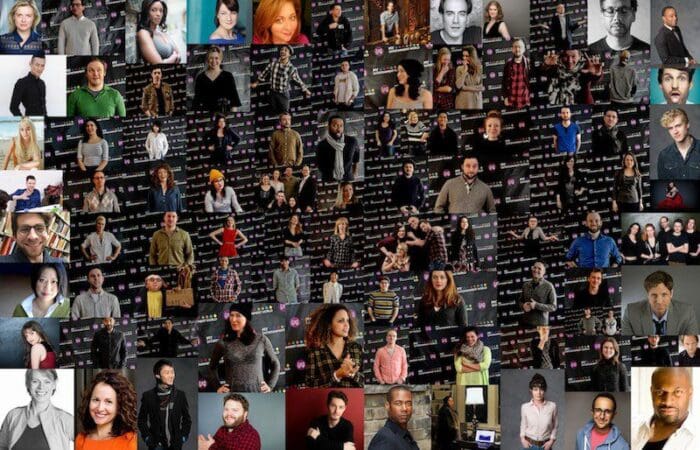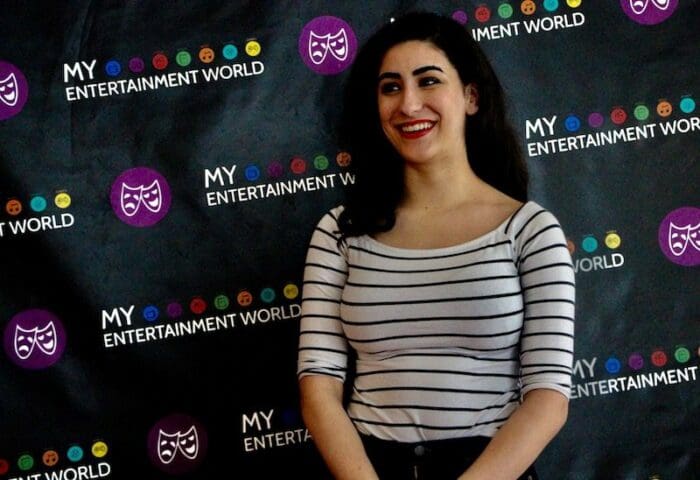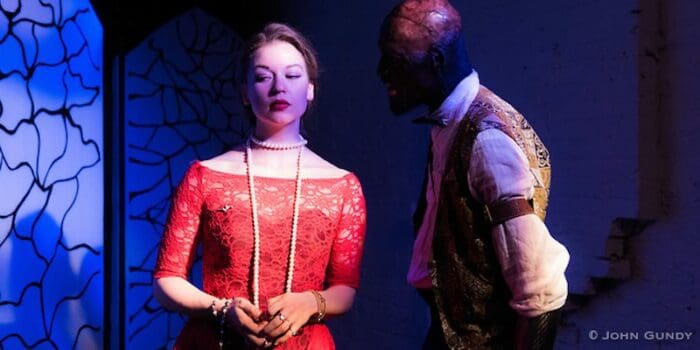 Before we announce the winners of the 2016 MyTheatre Awards, we’re proud to present our annual Nominee Interview Series.
Before we announce the winners of the 2016 MyTheatre Awards, we’re proud to present our annual Nominee Interview Series.
Smart, detailed, and ambitious, Julia Matias has started to carve out a really interesting career as a performer, director and designer in Toronto by seeking mentorship from established artists and leaving a trail of excellent impressions in her wake. Her first MyTheatre Award nomination (for Outstanding Set & Costume Design) is shared with one such mentor, Claire Hill, who brought Julia onto Desiderata Theatre Co’s Changeling: A Grand Guignol for Murderous Times where together they melded past with present and created opulence out of coroplast.
 Do you remember your first experience with theatre?
Do you remember your first experience with theatre?
The earliest ever was in senior kindergarten when someone else couldn’t play the Virgin Mary in the Nativity play, and I got to. It was very exciting, an early memory. And after that, when I was like 14, I did a program that Soulpepper was running with U of T. It was a thing where you stayed at one of the U of T residences and you worked with a bunch of artists all week, and you put together a creative collection. I think that was the first really formative experience where I felt a lot of the things people feel that keep them coming back and being involved in theatre. I think that I really internalized this disembodied feeling of connecting with an audience, and the idea of appealing to people, which I’ve continued. I still perform a lot but, when I’m not performing, it’s still a mentality I try to keep up- working in design, working as a director, thinking about community and engagement and rooms where people are together, actually, not just together in space. I think theatre’s one of the only spaces that we still have left that does that.
What was the first design you ever did?
The first one that was really realized in a real way that made me feel like a concrete designer was with Claire Hill, who I worked with on this project. She brought me on as an assistant after meeting me really briefly at a Monday night of new works, because I’d mentioned that I was interested in costume design, and applying to the costume design program at York, which was where I did my undergrad. So she brought me on, just out of the blue, cold-called me and asked me to do this project with her for a show called Firebrand, which was in Mackenzie House, about the person who lived in that house, who was an important Canadian politician. She just had me do small assistant stuff- like ironing things every day, coming and washing stuff- but she gave me a costume to design; I think it was Michael Rawley’s costume, which was really cool. It was really fun to be able to draw it out, do a proper rendering, and then source everything and fit it all.
How did you get involved with Desiderata?
Similarly, through Claire. I was doing my masters degree in performance studies; I finished the degree, and it was a very long, committed process. I asked Claire what she was working on, if there was anything that she knew of that I could get involved with quickly, because I was kind of hungry to work. And she recommended Changeling, mostly because it seemed like a cool project that she thought we could collaborate on well, and also because its aesthetic was something I was really interested in. That idea of Grand Guignol- kind of old-timey meets contemporary costuming- was really, really exciting. And her designs for the set that I sort of helped her collaborate on were really cool too. This idea of creating space and creating shadow and terror and how to stage that on a budget in a small space was really enticing to us. So that was my introduction to the company, through her.
You mentioned the budget was really small, but it’s a story about aristocrats, meaning you had to create fancy things with no money. How did you go about doing that?
We used coroplast [for the set]. What was funny is we’d used it before, and in 4 1/2 (ig)noble truths after; it was the summer of this stuff. Coroplast is cool-looking. It provides things like shadows, is malleable and easy to cut into different shapes and retain shape well. But it’s super cheap to buy in huge packages. I think a lot of designers always need to consider, first and foremost, their materials, and what’s feasible to do with a small budget. And obviously, of course, what you can reuse or borrow or whatever. But also what you actually can make aesthetically interesting through purchase, as long as it’s within a certain monetary space.

Tell us a little bit that marriage of time periods, especially with regards to the costumes.
So some of it was simply because we couldn’t afford to do 17th century costuming. Some of it was trying to bring in those Gothic influences from that Grand Guignol kind of look. I think the most popular cultural reference people might remember was the theatre in Interview with a Vampire- it’s supposed to be a Grand Guignol theatre. It’s this idea of very rich, Gothic-inspired deep fabrics and bold colours. Thinking through how to do that, but also understanding that the whole point of this play was that it was an adaptation of the original Changeling. So how do you contemporize some of the feelings of these characters? For example, what does John [Chou]’s character [Alonzo] feel like in the 21st century? Claire used Kanye West as a big inspiration for his look, so it’s this idea of “how do we show wealth today”, or “how do we show stature today?” And how can we make sure that that’s read by the audience while still feeling like they’re being transported to something other than their own reality?
How much guidance were you given by the director Harrison Thomas on the aesthetic of the show?
He said he wanted it to be Grand Guignol but he was cool with our idea to contemporize parts of it. He looked at pieces and made sure they were okay and, obviously, we also checked in with all the actors to make sure [we picked] things that they felt they could move in. [Harrison] definitely had an aesthetic, but I think he trusted us and chose a good team, so there was never a point where we felt that we were in the wrong direction and we needed to reel back to whatever it was that he wanted instead.
What were some practical demands of the production that you had to work around?
We had to make a lot of blood that could wash out completely every night and that wasn’t too slippery. So we had to screw around a lot with a couple of different recipes until we found something that worked, and then found devices that worked to project it. For some people, it would just be on their bodies. Others, we had a syringe that we had to figure out where that was going to go, and where to pre-set all these blood pieces. Some people needed more blood, or a thicker recipe or something like that, so it was a lot of figuring out how to do all that, whilst still thinking about the fact that our coroplast sets were a little transparent, so we also had to make it so that there was space so that people could leave those implements without them being seen, without the squirting being visible to people who were watching.
Tell us a little bit more about your collaboration with Claire Hill. What is it about your partnership that works?
Good question. I think it’s a variety thing. I’d assisted for Claire a bunch of times before Changeling. Claire’s very direct in what she wants, and definitely is the kind of person who’s a go-getter and will make sure her vision goes as far as possible and doesn’t really compromise it. But she is simultaneously very open to people interpreting and riffing off of that. So, I think we have a good relationship where we can work together effectively. And we’re both good with small budgets and putting in a lot of hours and supporting each other. I think we always feel like the other person cares for who we’re working for, as opposed to working with people who are only there to do their job, and not really to expand out of that. So I think those things have been really cool. And we also have similar aesthetics.
I definitely think, from my end, a lot of it has been more of a mentorship than it’s been a collaboration. I feel like I’m constantly gaining, constantly learning skills from Claire- how to do certain things, how to use certain power tools, or how certain things need to be set in tangible real-life practice. But I think we keep working together because she likes working with me, and likes that I’m competent, and likes that I’m trustworthy, and trusts my aesthetic sense.
If you had unlimited time and budget, what would the set and costumes have looked like?
I think the space that was rented would have been much bigger, possibly. I would have just wanted a deeper stage, maybe a wider stage. Almost just a more grandiose version of what we ended up having. Instead of coroplast, maybe like a plexi or something. Bigger, angular shapes, wheels that could be rotated around- I think that was still an incredible design choice that allowed them to do everything they wanted. And to take that away from the world would potentially have kind of mucked it up. I think we could have used some more expensive materials for some of the actor stuff, but ultimately I think a lot of the costumes suited the play, and worked really well, given the circumstances. To just throw money at them, I don’t think would have necessarily made them better. I think those are the only things I’d change.
What was your favourite design element of The Changeling?
I think, in terms of costuming, what we did with Prince [Amponsah]’s prosthetic was really cool, and very creative. We treated the length of his arm as a gift that we could grow on, and that we could develop character through, as opposed to something that we had to hide or cover. It became something that helped his performance, I think, and helped the arc of the play, and helped him be read the way he was supposed to in that show.

As you mentioned earlier, you also worked on 4 1/2 (ig)noble truths last summer. Tell us a little bit about your experiences on that production.
So I was working in a different role with that. I was assistant directing, which was really cool because, creatively, it was a [story] that I felt really needed to be told. Specifically in this particular context, from Tom [McKechnie, playwright/performer], because he has such a way of describing that experience whilst still being inclusive, and still being poetic, and really allowing you into his world, and into his understanding of what it means to live with clinical depression. It felt like something that could actually bring about important societal change in terms of understanding, and treatment, and helping people feel less alone. So that was really great; in that capacity, working on it was really cool. But, just as much, it was an incredibly difficult production to work on because, by its very nature, it’s difficult, and triggering, and requires care and requires time. It required a lot of love from all of us. So, at the end of it, it was a really beautiful experience, but it was trying, and it did involve many hours of rehearsal and a lot of really hard work, which we’re really thankful paid off in a really important way.
The director of that project Michael Reinhart is nominated for Outstanding Direction. What’s it like working with him?
It’s great working with Mike. I’ve worked with him a lot- both as a performer and as an AD or as a co-collaborator. Mike was wonderful about that piece because he really allowed it to be what it was supposed to, if that makes any sense. He showcased the poetry and the writing of the piece, and what made it great, while being able to bring in important attributes and elements and physical exercises that helped Tom stage or enact what he was talking about. That helped it push forward and push Tom as a performer, as well, into an emotional place that was going to read better.
What are you doing now/what’s your next project?
I work really consistently as a burlesque performer in the city, 2 or 3 times a week. I just got back from New York City, performing a bunch. So I’m always doing that, and I’m working on my doctorate at U of T also mostly writing about that. So that’s what I’m doing as a performer outside of theatre. In terms of theatre, within the next few months, I’m starting up a kind of cabaret, or a small performing space, which centres its work around feminism. Mostly women and non-binary people, but it’s going to be open to a few cis men and is a place for experimentation and artistic growth and talking about the political climate as it is now, and dealing with the place we find ourselves in. Because, since Changeling and 4 1/2 (ig)noble truths, our world in an American context has gotten a lot darker. And, especially as a young woman, I feel like we don’t have as much stage time as we want, to grow as artists. There aren’t enough places for us to go, and those places are already saturated. It’s not just with us, it’s with everybody. Something like Crapshoot, for example, or even QueerCab, they’re amazing, but they’re either exclusionary- and they should be, because certain communities need spaces- or they’re already full, because they have to be. So we want to create a space where people can come at any point in their artistic career, and share, and try stuff, and feel supported, and feel like they have a community. So that I’ll be starting, we’re looking at doing the first one in May.
Do you have anything you’d like to add?
I feel like both projects are really important, and deserve time in different ways. So many things on the [nomination] list were great because they were speaking to a specific moment, or to a specific issue. Thinking about how what we make has to talk to something, I think, should be really important, especially as we move forward.
